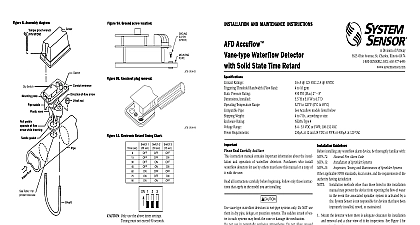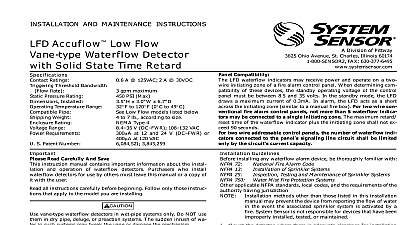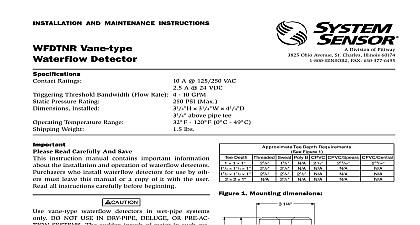System Sensor accuflow-afdt Install and Maint Instructions

File Preview
Click below to download for free
Click below to download for free
File Data
| Name | system-sensor-accuflow-afdt-install-and-maint-instructions-8571632094.pdf |
|---|---|
| Type | |
| Size | 707.58 KB |
| Downloads |
Text Preview
I56 1621 000R Manuals Online 1 for mounting dimensions and removal and a clear view of it for inspection See the detector where there is adequate clearance for in tested or maintained for devices that have been improperly in is activated by a fire System Sensor is not re flow of water in the event the associated sprinkler manual may prevent the device from reporting methods other than those listed in this in of the authority having jurisdiction follow other applicable NFPA standards local codes and the 25 Fire Protection Systems Testing and Maintenance of Water Four Sories in Height for Residential Occupancies up to and Homes for 1 and 2 Family Dwellings and of Sprinkler Systems Fire Alarm Code 13D 13 72 with installing any waterflow alarm device be thoroughly Guidelines 13R Vane and Bottom of Flange Fit Between Top of End of Paddle Tree Fitting Depth to Depth Adapter 1 Mounting dimensions at 12 or 24 VDC or FWR 400 at 120 VAC 33 VDC or FWR 108 132 VAC use only as tested by U L Type 4 as tested by Underwriters Laboratories Inc U L lbs 120 0 49 39 16 63 4 33 4 63 4 PSI Max 10 GPM A 125 VAC 2 A 30 VDC 1 1 DepthThreadedSweatPoly B CPVC 11 2 1 11 4 1 2 1 Figure 1 Tee Depth Requirements for recommended tee depths tees having a 1 threaded NPT branch see Figure 1 and 1 to 2 sweat brass 11 2 polybutylene plastic and 1 cpvc AFDT and AFDTH fit 1 to 11 2 NPT threaded ferrous and Pipe Tees activate if the flow rate is less than 4 gpm of water greater than 10 gallons per minute gpm but will delay has elapsed All detectors will activate on a sustained they reset if the flow of water stops before the AFDTs have a controlled delay mechanism Delays are delay of the vane produces a switched output usually after a systems Water flow in the pipe deflects a vane waterflow detectors mount to water filled pipes in Of Operation Do not leave unused wires exposed the mechanism Do not use in potentially explosive atmo inrush of water in such systems may break the vane off or USE IN DRY PIPE DELUGE OR PRE ACTION SYSTEMS The vane type waterflow detectors in wet pipe systems only DO before beginning or a copy of it with the user Read all instructions waterflow detectors for use by others must leave this and operation of waterflow detectors Purchasers who instruction manual contains important information about the Read Carefully And Save AFDTH can be installed between 2X4 stud wall construction Requirements Range Rating Weight Temperature Range Installed Pressure Rating Threshold Bandwidth Flow Rate Ratings FAX 630 377 6495 3825 Ohio Avenue St Charles Illinois 60174 Division of Pittway Waterflow Detectors with Solid State Retard Accuflow AND MAINTENANCE INSTRUCTIONS 2 Assembly diagram tlilSJIT Voltage Electrocution Hazard Do not handle live AC wiring or on a device to which AC power is applied Doing so may result in or death sure the direction of flow arrow points in the right direction a waterflow condition will go unreported See Figure 2 the sprinkler system with water and check for leaks around the or AFDTH If there is a leak check to see that the fittings are If leak persists drain the system and remove the detector removal instructions under Maintenance Check for damaged or cracked fitting Reinstall the detector and check again leaks Do not proceed until all leaks have been stopped All models have two wires and two sets of terminals Wires W1 W2 designated on PCB These wires are to a latching normally open as in No Flow relay con They are isolated from all electronics They will close and a short when water flows and the retard time elapses They remain shorted until waterflow stops Once waterflow stops contacts will re open Terminals T2 designated on PCB This is a two screw block The Accuflow gets its power from these termi These terminals must have voltage present from the FACP or suitable source of power before anything will work If no is present the Accuflow will not provide proper alarm sig These terminals will accept power in any polarity as well as power Relay Terminals T1 designated on PCB This is a THREE terminal block These terminals are connected to a latching C relay In no flow conditions COM is connected to A flow is detected COM will disconnect from A and connect B This relay will latch in that state and reset after water stops Adjust Dip Switch to desired time delay See Figure 11 For Dip location see Figure 2 When connected to a listed sprinkler fire alarm control panel initiating circuit must be nonsilenceable A ground screw is provided with all waterflow detectors When is required clamp wire with screw in hole located conduit entrance holes See Figure 9 page 4 If a second conduit entry is required remove the knockout plug a flat blade screwdriver as shown on Figure 10 page 4 sharply with a hammer to pierce the wall of the knockout Move to an adjacent wall section and repeat until the plug out Make sure that the waterflow detector is supported during this operation to avoid injury Power terminals must be connected to FACP or other initiating circuit Locate the detector 6 to 7 feet above the floor to protect from damage On horizontal runs position the detector on top of the pipe or the side of it Do not mount it upside down because conden may collect in the housing and impair the operation of detector For vertical flow applications mount detector on where upflow conditions exist Failure to do so may pre unit from operating properly Mount detector at least 6 inches from a fitting which changes direction of the water flow or no closer than 24 inches from valve or drain BE SURE DIRECTION OF FLOW ARROW MATCHES ACTUAL OF FLOW IN THE PIPE Instructions The AFDT and AFDTH waterflow detectors are designed to fit the appropriate tee fitting of tee perpendicular to flow of water must have a 1 thread Do not use a reducer to achieve the correct size Failure to follow this instruction will result in of the detector to report a waterflow condition AFDT and AFDTH units are shipped without paddles mounted the actuator Select the correct size paddle for the type of tee used Align hole on stem of paddle with hole on actuator Fasten together using a 4 40 x 1 4 fillister head screw in bag assembly See Figure 2 Use only the screw pro with the unit Drive screw head through hole in paddle it seats to actuator lever surface No washer is required paddle replacement refer to Maintenance section Carefully roll the vane opposite the direction of flow and insert tee Thread detector onto tee fitting and tighten with Use of thread sealant or tape is recommended Use gage located at end of paddle tree to ensure proper of detector on tee fitting See Figure 1 Height gage must between top of tee fitting and under side of hex tee adapter gap between gage and tee adapter is acceptable When cor installed the detector must face in the proper direction of and be aligned with the pipe Remove the metal cover Move the actuator lever back and forth check for binding If the vane binds remove the detector and the problem before proce


